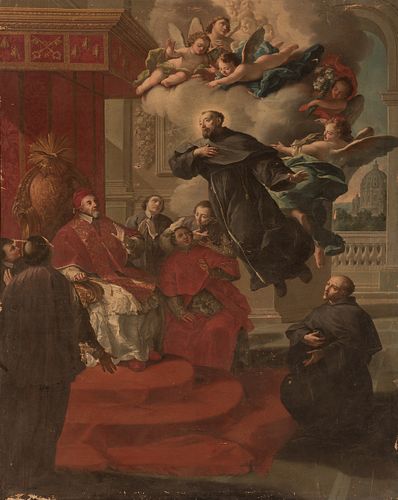Roman master; 18th century. "St. Joseph of Cupertino, levitating in front of Pope Urban VIII". Oil on canvas.
Lot 101
About Seller
Setdart Auction House
Carrer Aragó 346
Barcelona
Spain
Setdart Subastas was born in 2004 and is currently the first online art auction in Spain with solidity, prestige and reliability guaranteed by our more than 60,000 users. Setdart has a young, dynamic and enterprising team ready to successfully manage the purchase and sale of art works through custom...Read more
Estimate:
EUR€9,000 - EUR€10,000
$9,677.42 - $10,752.69
Absentee vs Live bid
Two ways to bid:
- Leave a max absentee bid and the platform will bid on your behalf up to your maximum bid during the live auction.
- Bid live during the auction and your bids will be submitted real-time to the auctioneer.
Bid Increments
| Price | Bid Increment |
|---|---|
| EUR€0 | EUR€10 |
| EUR€200 | EUR€25 |
| EUR€500 | EUR€50 |
| EUR€1,000 | EUR€100 |
| EUR€3,000 | EUR€200 |
| EUR€5,000 | EUR€500 |
| EUR€10,000 | EUR€1,000 |
| EUR€20,000 | EUR€2,000 |
| EUR€50,000 | EUR€5,000 |
About Auction
By Setdart Auction House
Oct 20, 2021
Set Reminder
2021-10-20 07:30:00
2021-10-20 07:30:00
America/New_York
Bidsquare
Bidsquare : OLD MASTERS
https://www.bidsquare.com/auctions/setdart-auction-house/old-masters-7700
Setdart Auction House sofia@setdart.com
Setdart Auction House sofia@setdart.com
- Lot Description
Roman master; 18th century. "St. Joseph of Cupertino, levitating in front of Pope Urban VIII". Oil on canvas. Presents walls and extensions on the sides, with canvas and original warped frame. Measures: 224 x 172 cm. In this devotional scene is represented the levitation of the friar San José de Cupertino, in front of the Pope Urbano VIII, which is recognized by the presence of the emblem of the bee, located in the sofa where he is seated. Symbol of the Barberini family to which the pontiff belonged. Regarding the Saint, Joseph Cupertino, he was a friar from Naples, belonging to the Franciscan order. As a child, he began to experience ecstatic visions, which continued throughout his life, and made him an object of scorn. He tried on several occasions to enter religious life, but was rejected on numerous occasions, until he was admitted by the Franciscans as early as 1625. During his religious life, he was known for his ability to enter into ecstasy and to levitate, being removed from the choir by his superiors, due to the frequency with which these "miracles" occurred. After the diffusion of these facts, his credibility was questioned, and he was accused of swindling, so much so that he was sent to Rome, in front of Pope Urban VIII. It was in this meeting between the two that the saint again entered into ecstasy and levitated, so that not only the Pope believed him, but also Prince John Frederick, Duke of Brunswixk-Lüneburg, at that time a Protestant, who decided to convert to Catholicism. In this particular scene, the saint is placed in the center of the composition, accompanied by a group of small angels, arranged above his head. In the earthly part of the scene, the Pope, elevated on his throne with respect to the rest of the characters, contemplates the scene in surprise, as well as the group of religious that complete the image. By the disposition of the characters, added to the golden tonality of the atmosphere that surrounds the scene, and the magnitude of the architecture, the scene stands out for the great theatricality with which the subject has been treated. A characteristic of the Catholic religious painting of the time, influenced by the ideals of the reform, which tried to surprise the faithful and bring them closer to the magnificence of a church in full decadence.
- Shipping Info
-
In-house shipping available. Please inquire at admin@setdart.com.
-
- Buyer's Premium



 EUR
EUR CAD
CAD AUD
AUD GBP
GBP MXN
MXN HKD
HKD CNY
CNY MYR
MYR SEK
SEK SGD
SGD CHF
CHF THB
THB









